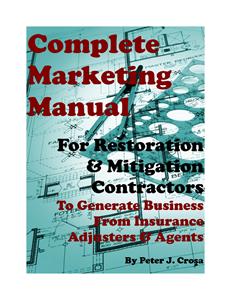Tis’ the Season for Insurance Renewal






More businesses renew their insurance on January 1 than any other day. Today there are more firms “specializing” in insuring restoration firms than ever before. The competition in the insurance market place has created potential opportunities to buy insurance for much less than the cost of providing that insurance. While that may sound as exciting as getting a pair of socks in your Christmas stocking, these gifts from the insurance elves will save some larger firms enough money on insurance this year to buy a real truck – and not a toy truck - for Christmas. But how do you find the best insurance values when there are over 2,000 insurance companies and 300,000 insurance agents to choose from?
What we could all use is a catalog for insurance policies - like the Sears toy catalogs that appeared in mail boxes around Christmas time in the 60’s. A catalog would make shopping for business insurance a lot easier. Hence, below is my version of an insurance catalog for restoration firms.
Eighty eight percent of restoration firms are insured under traditional General Liability (GL) insurance policies. Hundreds of different insurance companies write GL insurance on restorers, although almost all of these insurance companies officially say restoration firms are a prohibited class of business for them. I know that is confusing, it confuses me too. The insurance market for (GL) policies is stable with premium increases generally under 5% for 2013. Do not expect the usual 20% premium savings on your insurance renewal this year.
The majority of restoration firms purchase a standalone GL policy. I’m not a proponent of that insurance design. There are three fundamental and irresolvable insurance coverage design flaws in a traditional standalone GL policy on a restoration firm:
1. The fungus (mold) and bacteria (Category 3 water) exclusion endorsement excludes more than any separately purchased Contractors Pollution Liability (CPL) policy can cover.
2. The failure rate on meeting common contractual insurance requirements in the restoration business approaches 90% on traditional GL policies, which leaves the insurance buyer potentially uninsured for their contractual indemnification agreements.
3. There is no possible way to coordinate the claims process between the GL and CPL policies if they are purchased from different insurance companies.
With such powerful disadvantages to a standard GL insurance policy, you would think that insurance agents would have moved all of their customers to customized liability insurance packages years ago. But traditions carry on, the majority of restoration firms operate with fundamentally flawed and unnecessarily expensive liability insurance program designs, eight years after the combined policy forms, which eliminate the above flaws, were introduced to the market place.
Restoration company owners have more options today than ever before to insure their firms with custom crafted insurance packages for the restoration business. Significant new offerings in 2012 include:
• Admiral Insurance Company: A member of the Berkley Group of insurance companies (A+, XV) entered the restoration contractor insurance market in September 2012 offering policies with deductibles and minimum premiums at about half of their more established competitor’s pricing on these parameters. The Admiral combined GL/CPL/Professional policy is particularly attractive for firms with under $400,000 in annual revenues where minimum premiums are a big determining factor in the overall value proposition. Like any new entrant into the restoration insurance market, expect some glitches in the interface between the policy form and the insurance specifications of the various franchise organizations and networks. This will be a factor until the new policies work their way their way through the insurance requirements compliance cycles. Being red-lighted is a definite possibility in buying any new policy form. Underwritten by Freberg Underwriters in Denver (owned by Willis, an international insurance brokerage firm) the policies are available through wholesale insurance brokers who work with local insurance agents, or through local retail insurance agents. The costs of the Admiral insurance policies are the same through either distribution channel.
• Nautilus Insurance Company: (rated A+, XV) Part of the Berkley group of insurance companies based out of Connecticut. A well-established provider of insurance products to the restoration contracting market place, Nautilus has introduced a customized liability insurance package designed specifically for firms who are part of the Crawford Contactor Connection network. This insurance product is offered exclusively by ARMR Network, LLC through hundreds of thousands of insurance agents across the US. The package GL/CPL/Professional liability policy features premium discounts for good POMS scores, the shortest insurance application and procurement process in the restoration business (the application is only 2 pages long for water mitigators), insurance coverage off-the-shelf that meets the Crawford Contractor Connection insurance requirements and 100% compliant insurance certificates (no red light risk) issued by the insurance underwriter - not the local insurance agent - which significantly reduces the stress of insurance agents and owners alike in the annual recertification process at Contractor Connection. Pricing tends to be middle of the road, but the Nautilus policy offers an exceptional combination of features, market stability and price.
• Philadelphia Insurance Company: (A++, XV) Owned by Tokio Fire and Marine, one of the largest insurance companies in Japan, and entered into the restoration contractor insurance market with a cannon ball-sized splash in September 2012. Early price comparisons show Philadelphia Insurance is able to shave more than 60% off the cost of business liability insurance on established restoration firms. Another unique feature is buyers of Philly insurance policies can charge the insurance premiums on their credit cards. Expect some coverage glitches in complying with insurance specifications as the insurance underwriters learn the restoration business. (See the July/August edition of R&R for more information on managing risks in contracts.)
It is interesting to see new players in the restoration contractor market considering that the first three insurance companies that specialized in insuring restoration firms on state-of-the-art GL/CPL/Professional liability package policies have either abandoned or are in the process of abandoning the class of business entirely. Insurance companies never leave a class of business because they are making too much money, so I have to assume adverse loss experience got to these carriers over time.
The exit of the old timers does not spell tidings of great joy for the new entrants into the restoration contractor insurance market. When these early adopters entered the insurance market place for restoration firms seven to eight years ago, the rates for liability insurance were more than 50% higher than what they are today. Shaving 60% off of the current rates for liability insurance means that some restoration firms will be getting their business liability insurance at rates that are at least 80% less than the pricing that drove some very large insurance companies out of the restoration contractor insurance business all together. That’s super cheap insurance. If you can get access to a deal like that and the coverage is OK, buy big limits with all of the bells and whistles. On average, if you were able to play the game forever, you can expect to get $3 to $5 back in paid claims for every dollar of premium you spend.
While literally hundreds of different insurance companies sell GL insurance policies to restoration firms, these firms specialize in insuring restoration firms on the state-of-the-art combined GL/CPL/Professional liability policy forms:
• ACE Westchester Environmental: Established to service the hazardous waste clean-up contractor market, Westchester insurance company rode the mold wave into the restoration contracting business. The policy form has been through enough compliance reviews so that it complies with most insurance specifications right out of the box.
• American Safety Insurance (ASI) Company: Formed by a group of asbestos abatement contractors 25 years ago, ASI is the oldest supplier of specialized environmental/liability insurances for contractors in the world. Its combined GL/CPL/Professional insurance policy has been specifically adapted to restoration firms and off-the-shelf can comply with the insurance requirements of franchises and networks.
• Arch: An insurance company with a wide range of offerings, Arch features a combined GL/CPL/Professional policy with customized mold coverage and exceptionally high aggregate limits for each coverage section.
• C.V. Starr: A firm founded by the famous AIG founder Hank Greenberg, C.V. Starr offers a combined policy form and can also offer workers compensation and automobile liability insurance. Its liability policy has not been adapted specifically for restoration firms.
• Colony: A well-established provider of liability insurance packages to the hazardous waste contracting market, Colony recently made revisions to their GL/CPL/Professional policy form that made it better suited to the restoration market.
• Gemini: Another member of the Berkley group of companies, Gemini features a unique GL/CPL/mold policy fashioned off of an asbestos abatement contractor’s insurance policy. While not providing a separate Professional Liability coverage part, it is the only policy available without a professional exclusion in the GL/CPL coverage.
• Nautilus: The third member of the Berkely Group on this list to offer combined GL/CPL/Professional liability policies to fire and water restoration firms. This is the most customized policy form in the market place. It has been designed to provide the best available coverage, as even claims processes have been modified for working with the larger networks. Design features include ease of procurement and policy maintenance over the course of the policy term. ARMR Network LLC underwrites this policy. Nautilus also offers workers compensation and business automobile liability coverages to restoration firms.
• Rockhill: One of the early adapters to use the GL/CPL/Professional combined policy form on fire and water restoration firms, Rockhill features a cafeteria approach to coverage. This “only sell what the customer asks for” approach on coverage allows Rockhill to be a low-price leader. By amending its policy with endorsements (usually each one has an additional premium), Rockhill is able to satisfy virtually any coverage need for franchises and networks.
For firms that are maintaining separately purchased GL insurance policies and CPL policies, there are 38 choices for CPL insurance. Here are the industry leaders for CPL coverage on restoration firms:
• Liberty: A solid provider of coverage on a customized policy form that, off-the-shelf, basically provides almost all the coverage a restoration firm would ever need on a CPL policy.
• Chartis: The surviving company of AIG, it invented CPL in 1986 and knows a lot about the coverage line. Its policy form has not been adapted to the restoration business specifically, expect to make modifications to the policy form to meet insurance requirements in restoration contracts. Its policies are usually inexpensive once the common $10,000 minimum premium is surpassed.
• Axis: The underwriters at Axis recognized the need for an admitted CPL policy in the market place and have worked diligently to get their CPL policy filed for use in 48 states. The big advantage to having admitted insurance is the avoidance of having to pay a separate premium tax and the fees that brokers commonly charge to handle paying those taxes.
Finally, some tips for less stress and spending more time with family and friends during the holidays.
1. Utilize the services of a specialist insurance broker to navigate the insurance market place. You can spend three months on your insurance procurement or three days with someone who knows your business and your insurance needs.
2. Move the renewal date of your insurance away from the holiday season. If I had my way, I would not have any customers renewing their insurance between December 15 and January 10. That’s the time period when underwriters are out of the office, which makes getting the best available terms almost impossible. I recommend moving the inception dates of your insurance policies away from this period.
The insurance elves have put together some interesting choices this year. I wish somebody would invent insurance alternatives for my business that were half as good as the choices restoration firms have. Hopefully the above catalog will help you and your insurance agent find the insurance you need for your firm.
Looking for a reprint of this article?
From high-res PDFs to custom plaques, order your copy today!











